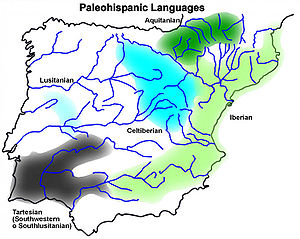Paleohispanic languages


The Paleohispanic languages were the languages of the Pre-Roman peoples of the Iberian Peninsula, excluding languages of foreign colonies, such as Greek in Emporion and Phoenician in Qart Hadast. After the Roman conquest of Hispania the Paleohispanic languages, with the exception of Proto-Basque, were replaced by Latin, the ancestor of the modern Iberian Romance languages.
Classification
Some of these languages were documented directly through inscriptions, mainly in Paleohispanic scripts, that date for sure between the 5th century BC, maybe from the 7th century in the opinion of some researchers, until the end of the 1st century BC or the beginning of the 1st century AD.
- Iberian language
- Celtiberian language
- Gallaecian language (also known as western Hispano-Celtic).
- Tartessian language (also known as the language of SW or South Lusitanian inscriptions)
- Lusitanian language
Other Paleohispanic languages can only be identified indirectly through toponyms, anthroponyms or theonyms cited by Roman and Greek sources.
- Aquitanian language
- Sorothaptic language (also known as Italoid)
Of these languages, Celtiberian, Lusitanian, presumably Sorothaptic and perhaps Tartessian were Indo-European languages; Celtiberian was a Celtic language, and Lusitanian and (according to a new proposal) Tartessian[1][2] might have been, but the hypothetical Sorothaptic was not. Tartessian and Iberian are generally considered unclassified languages,[3] while Aquitanian was a precursor of modern Basque.
See also
References
- ^ Koch, John T (2010). Celtic from the West Chapter 9: Paradigm Shift? Interpreting Tartessian as Celtic. Oxbow Books, Oxford, UK. pp. 187–295. ISBN 978-1-84217-410-4.
- ^ Koch, John T (2011). Tartessian 2: The Inscription of Mesas do Castelinho ro and the Verbal Complex. Preliminaries to Historical Phonology. Oxbow Books, Oxford, UK. pp. 1–198. ISBN 978-1-907029-07-3.
- ^ Broderick, George (2010). "Die vorrömischen Sprachen auf der iberischen Halbinsel". In Hinrichs, Uwe (ed.). Das Handbuch der Eurolinguistik (in German) (1st ed.). Wiesbaden, Germany: Otto Harrassowitz Verlag. pp. 304–305. ISBN 3-447-05928-1.
Further reading
- Correa, José Antonio (1994): «La lengua ibérica», Revista española de lingüística 24, 2, pp. 263–287.
- Jordán, Carlos (2004): Celtibérico, Zaragoza.
- Hoz, Javier de (1995): «Tartesio, fenicio y céltico, 25 años después», Tartessos 25 años después, pp. 591–607.
- Rodríguez Ramos, Jesús (2005): «Introducció a l'estudi de les inscripcions ibèriques», Revista de la Fundació Privada Catalana per l'Arqueologia ibèrica, 1, pp. 13–144.
- Untermann, Jürgen : Monumenta Linguarum Hispanicarum, Wiesbaden. (1975): I Die Münzlegenden. (1980): II Die iberischen Inschriften aus Sudfrankreicht. (1990): III Die iberischen Inschriften aus Spanien. (1997): IV Die tartessischen, keltiberischen und lusitanischen Inschriften.
- Velaza, Javier (1996): Epigrafía y lengua ibéricas, Barcelona.
